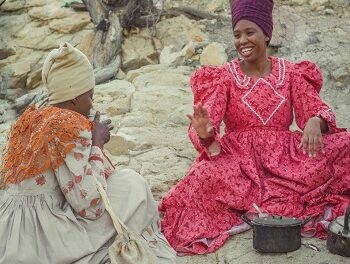
Historic collection of photographs show extensive history of Erongo rock art

Namibia’s emblematic rock art has fascinated both researchers and laymen for more than a century. Damaraland is arguably one of the richest rock art areas anywhere in the world, hiding a plethora of sites where pre-historic rock art is plentiful and well-preserved.
The most iconic single artwork, the White Lady of the Brandberg is also one of the most photographed. Today, thousands of tourists flock to this special site in the eastern cliffs of the Brandberg, hoping to catch a view of the famous lady.
The White Lady, although known for centuries by indigenous people, became famous in the mid-forties of the previous century when a French explorer brought pictures of the entire fresco in which the White Lady is only one of many images, to the western world. Before his expidition, the existence of the White Lady was known since German colonial times although the exact location was often in dispute.
The expeditions of the French archaeologist Abbé Henri Breuil and his collaborator Mary Boyle between 1947 and 1950 established the White Lady’s fame. The archives of the expedition photographers Anneliese and Ernst Rudolf Scherz offer unexpected glimpses into a time and period when the „White Lady“ and many other rock images were discovered by scientists and made visible by means of the camera. The photographs on display were taken at sites in the Brandberg/Daureb, in the Erongo and Spitzkoppe mountains. They depict the ordinary daily challenges during the research, show techniques of documentation, suggest controversy relating to rock art interpretation and confront viewers with the colonial contexts of expeditions, research and photography. The black-and-white photographs of Anneliese Scherz reveal surprising re-enactments and visual transformations, including the creation of a “Black Lady.“
As the White Lady became more famous, the surface of the fresco started deteriorating from so many hands touching the images. Also, there are many accounts of visitors using water to wash the rock to make the images stand out. There are even reports of people using Coke to wash the images. All this activity lead to the deterioration of the images and the White Lady site had to be protected by erecting a pallisade cage in front of the rock. Today, this restricts the view but it helps protect the ancient history.
The fascination with rock art has produced an endless number of photographs for more than a hundred years. Many of these older pictures have been collected by Basler Afrika Bibliographien and collated into a substantial collection. It is a selection of these images that are now on display in the National Art Gallery.
Elsewhere in Damaraland and the Kaokoveld there are literally thousands of rock art sites, all protected by the desolateness of the land and the arid climate.
For instance, these images abound in the Twyfelfontein areas and is one of the main drawing cards of establishments like the Twyfelfontein lodge.















































